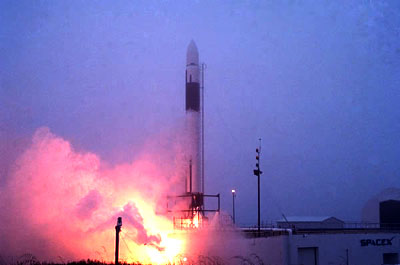The challenge of cheap orbital accessby Sam Dinkin
|
| Two CEOs we talked to said that they would not use the ranges if they were free. This suggests that some launch services may simply not be available on the federal ranges. |
Latrell’s second criticism is that we assume a reuse of 100 flights on a reusable vehicle. We agree that this number is aggressive given current practice. A more realistic near-term number would be lower. We tried to be similarly favorable to the economics in all of our assumptions. That is, we tried to choose the best numbers for the economics of spaceflight that the literature would credibly support based on historical systems. To the extent that there were more favorable numbers in the literature for mature systems of the future, we deconstructed those assumptions.
Other comments we have received are that our range cost estimates for small vehicles are too high. $700,000 is our new number for range and compliance costs for a 1,000-kg class vehicle vs. the $1.3 million we estimated. This is still $700/kg. This also underestimates the difficulties dealing with the range for commercial traffic. Two CEOs we talked to said that they would not use the ranges if they were free. This suggests that Musk’s estimate of compliance costs may be low and that some launch services may simply not be available on the federal ranges.
We were also told that our insurance cost estimates are high in contrast with Latrell’s experience. Here, effort needs to be made at reducing transaction costs by designing a low-cost iterative negotiation system. Transactions cost routinely eat 30% of premiums. Almost all insurance placements are priced above the market clearing price and the quantity of each insurer reduced pro-rata (written down). This is inevitable given legacy technology of phone calls from brokers to insurers to make a book. The historical write-down rate is a censored sample because brokers tend to stop calling insurers after enough insurance has been secured (layer has been completed). It is not in the interest of brokers to get low prices if they are paid a commission as a percentage of the insurance premium via the insurers (which New York Attorney General Eliot Spitzer has discouraged) or by the insured. A more aligned incentive would be to pay brokers a fixed fee for services rendered. Further, an auction can be used instead of an inefficient bookmaking exercise to quickly get to the market price for insurance. These modifications and other rationalization of terms can reduce insurance premiums 10–20%, but ultimately it will take higher reliability systems that have been flown many times to further reduce insurance sufficiently such that insurance costs approach $1,000/kg.
What all the preceding points mean is $1,000/kg is not really achievable in the 1,000-kg class launcher without changing the rules of the game. We are excited that Elon Musk is looking forward to $1,000/kg by 2010, but in order to make that achievable, SpaceX needs to accomplish future vehicle development at much lower costs than previous vehicles were developed. He also needs to achieve higher flight rates than previous vehicles. Our model does not support such low prices per kilogram with a flight rate of five flights per year and $1 billion development cost.
| Optimism here may be reasonable, but it is in stark contrast to the quantum leaps required to get from what we have today to mature systems that might have payload delivery costs only three times the cost of fuel, like airplanes. |
The interest and principal on the R&D alone would cost $30 million per flight if R&D is amortized over ten years at five flights per year and if Musk invests his own money at a 5% return. That would mean that we would need a payload capacity of 30,000 kg even if propellant, construction, and so on were free. So to get a “big gulp” rocket to cost $1,000/kg requires higher flight rates or lower R&D costs. Developing Falcon 1 (I) and Falcon 5 (V) for $100 million may imply the cost of developing Falcon 50 (L) and Falcon 500 (D) (my guesses at the names) will be a lot less than previous development costs for heavy-lift vehicles, but that would be a first. High flight rates are certainly plausible at $1,000/kg. I know I would buy 100 kg or so to fly myself to orbit if it only cost $25,000 after 1,000 successful flights in a row (or 50 in a row if I am George Bush Senior’s age), but it is an open question about whether such demand would materialize quickly enough for the project to be a financial success.
It is a fair criticism from Latrell that our point that suborbital experience with high flight rates will carry over to orbital is undeveloped. It is at odds with the rest of the points in our paper where we look to experience rather than hope. In this case, the history of mass production is pretty good at squeezing costs out. Optimism here may be reasonable, but it is in stark contrast to the quantum leaps required to get from what we have today to mature systems that might have payload delivery costs only three times the cost of fuel, like airplanes.
Look for a new draft of our paper in time for AIAA’s Space 2005 conference in Long Beach on August 30 reflecting these comments.
